17 Pink Houseplants To Add A Pop Of Color To Your Home
Say goodbye to dull green houseplants with selections featuring bold, vivid foliage.
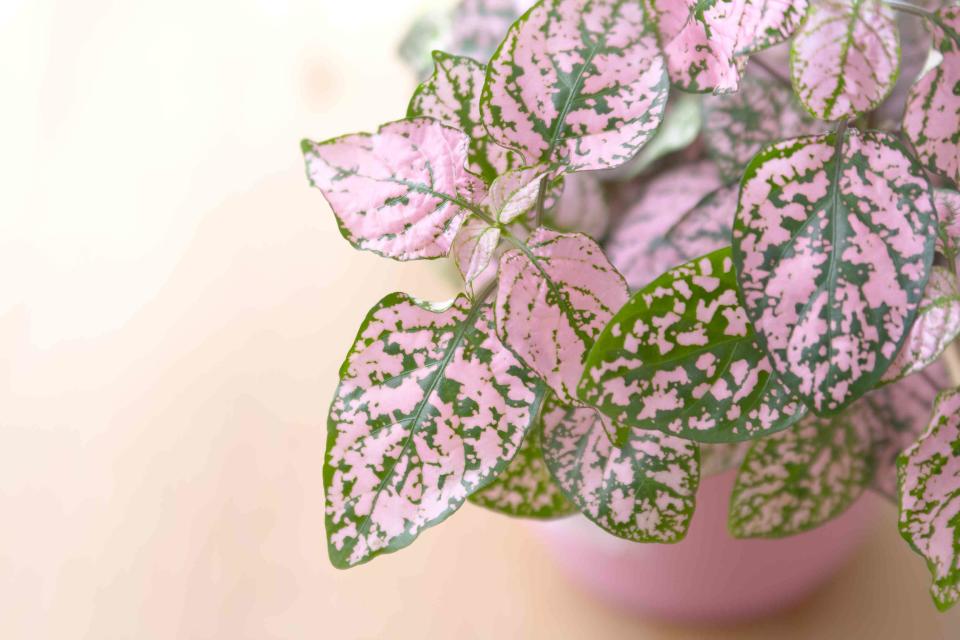
Getty Images
Looking to add a little flair to your home décor? These stylish pink houseplants bring unexpected color to containers. Featuring foliage in a range of pink hues, from vibrant magenta to the palest blush, these unique cultivars include many of our favorite houseplants, but with a colorful twist. Use these radiant foliage plants to accent pretty-in-pink flowering houseplants like orchids and cyclamen while providing year-round color. They also make memorable, lasting gifts for friends and loved ones.
Philodendron
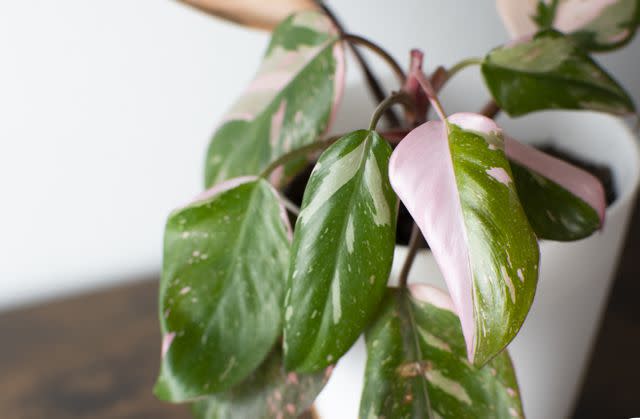
Getty Images / AnaSha
Botanical Name: Philodendron erubescens
Sun Exposure: Low to Bright Indirect Light
Soil Type: Well-draining, Rich
Soil pH: Acidic (5.0-6.0)
Philodendron is a popular houseplant thanks to its ease of culture and quick growth. Two stunning varieties sport mottled pink foliage. 'Pink Princess' is a stable pink philodendron, with deep green foliage splotched with bubblegum pink patches. A variant of this cultivar called 'Black Cherry Pink Princess' combines these vibrant pink hues with dark green to maroon, nearly black foliage. Both are gorgeous and quite challenging to produce, giving them a high price tag.
Calico Kitten Crassula
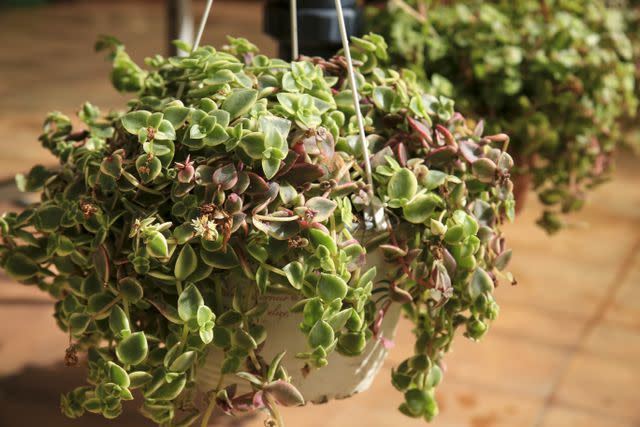
Getty Images / soniabonet
Botanical Name: Crassula pellucida 'Variegata'
Sun Exposure: Bright Indirect to Direct Light
Soil Type: Porous, Well-draining
Soil pH: Slightly Acidic to Neutral (5.5-7.5)
The adorable heart-shaped leaves of this succulent are sure to win you over with their delicate pink edge and green and cream centers. The foliage is densely packed on thin stems that trail over the edges of containers. Pink hues trimming the foliage are more pronounced when plants receive adequate light. Allow soil to dry slightly between watering.
Inch Plant
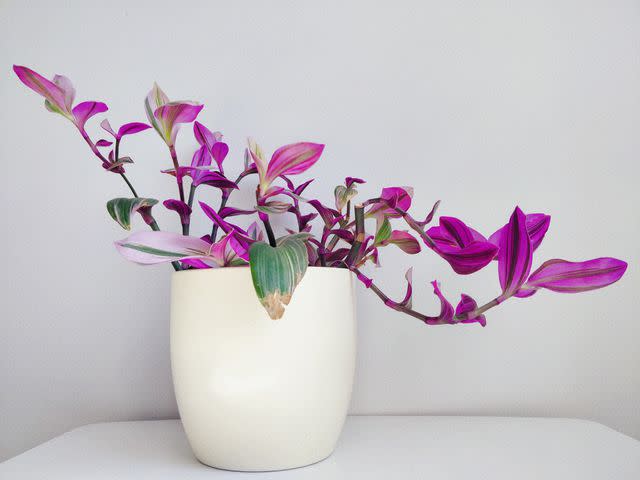
Getty Images
Botanical Name: Tradescantia fluminensis
Sun Exposure: Medium to Bright Indirect Light
Soil Type: Well-draining, Rich
Soil pH: Acidic (5.0-6 .5)
A great many varieties of inch plants (a.k.a. spiderwort) are available that feature pink tones in the foliage. Among the most popular is 'Nanouk,' which produces captivating pink foliage streaked with green, silvery-white, and purple. 'Tricolor,' which is also called 'Pink Princess,' is beloved for its softer pink tints and more rounded leaves. Pinch back the growing tips of inch plant to promote bushier growth.
Polka Dot Plant
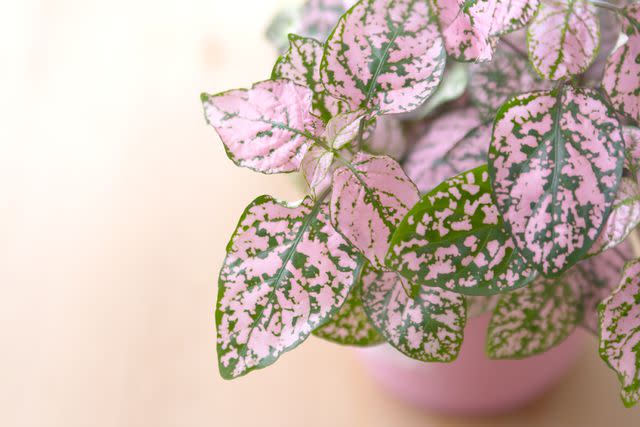
Getty Images
Botanical Name: Hypoestes phyllostachya
Sun Exposure: Bright Indirect Light
Soil Type: Well-draining, Rich
Soil pH: Slightly Acidic (5.5-6.5)
For a punch of color, try one of the many varieties of polka dot plant, each featuring splotches of pink against dark green foliage. Available in a range of shades from bubblegum to raspberry, varieties also include red and white forms. This tropical beauty prefers a humid environment. Mist plants regularly or keep them near a humidifier, especially in winter. Polka dot plants also work great in terrariums. Pinch plants back regularly to keep them compact. The cuttings root readily in water.
Arrowhead Ivy
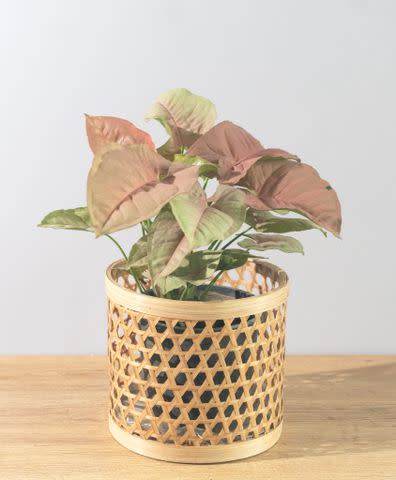
Getty Images
Botanical Name: Syngonium podophyllum
Sun Exposure: Medium Indirect Light
Soil Type: Well-draining, Rich
Soil pH: Slightly Acidic to Neutral (6.0-7.0)
This easy to grow houseplant grows upright when young, but as the plant ages, the stems will climb moss poles or other structures as they stretch skyward. Similar to caladiums in leaf size and shape, arrowhead ivy makes a better houseplant as it does not require a dormant period in winter. Pink varieties include those with speckled leaves, as well as solid-hued foliage blushed with pink. Allow soil to dry slightly between watering.
Rose Painted Calathea
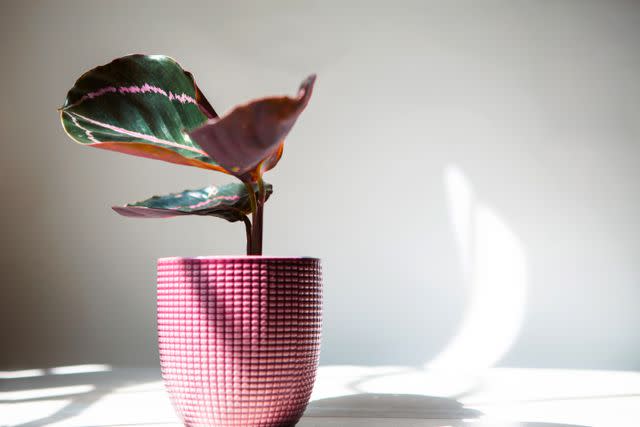
Getty Images
Botanical Name: Calathea roseopicta
Sun Exposure: Bright Indoor Light
Soil Type: Moist, Rich
Soil pH: Slightly Acidic to Neutral (6.5-7.0)
Rose painted calathea is a showstopper! The bold and rounded, deep green foliage of this tropical thriller is bursting with magenta pink which, in some cultivars, fills the entire center of each leaf. Other varieties boast pink stripes and veins. The undersides of the leaves are dark maroon for even more color. Hailing from the tropical rain forest, calatheas require misting or placement near a humidifier to provide a humid environment.
Prayer Plant
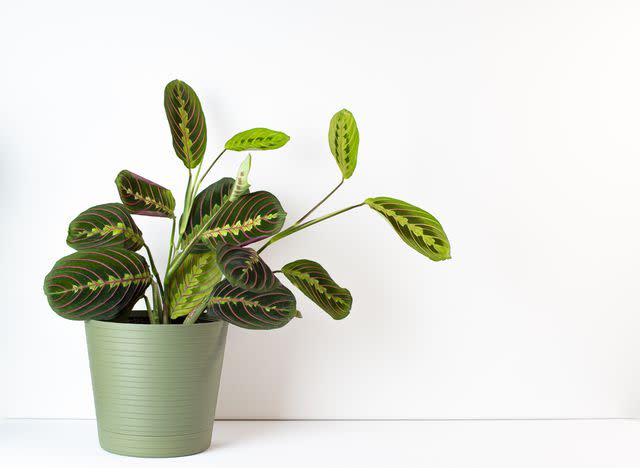
Getty Images
Botanical Name: Maranta leuconeura
Sun Exposure: Medium to Bright Indirect Light
Soil Type: Well-draining, Rich
Soil pH: Slightly Acidic (5.5-6.0)
Named for the habit of folding its leaves up at night like clasped hands, the prayer plant is a perennial favorite for the stunning patterning of its foliage. Large, oval leaves are deep green with chartreuse variegation along the midrib and pink veins curving toward the leaf tips. Provide a warm, humid environment. Prayer plants are sensitive to hard water, so mist and water with filtered water when possible.
Hawaiian Ti Plant

Getty Images / Kiki hadi Supriyanto
Botanical Name: Cordyline fruticosa
Sun Exposure: Bright Indirect Light
Soil Type: Well-draining, Rich
Soil pH: Slightly Acidic (6.0-6.5)
The broad strap-like foliage of cordyline is drenched in color. From the cerise pink stripes of 'Tango' to the neatly trimmed 'Pink Edge,' cordylines add drama to any setting and their upright habit lends a structural element to interiors. With time and care, ti plants can reach ten feet, but require ever larger containers to do so, and usually top out around three feet indoors. Ti plants are considered good luck and make a great housewarming gift.
Chinese Evergreen
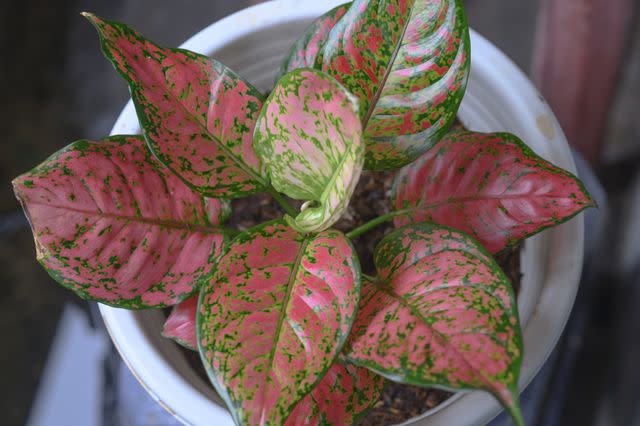
Getty Images / Andi Irawan
Botanical Name: Aglaonema spp.
Sun Exposure: Low to Medium Indirect Light
Soil Type: Well-draining, Rich
Soil pH: Slightly Acidic (5.5-6.5)
The pink stems of many Chinese evergreen cultivars set this plant apart from other houseplants. Some varieties boast pink edged foliage, others have leaves blotched with bright pink spots. And then there are cultivars with mostly pink leaves flecked with green. All are quite striking and easy to grow. Chinese evergreens like to be a little pot bound and only need to be repotted every two to three years.
Nerve Plant
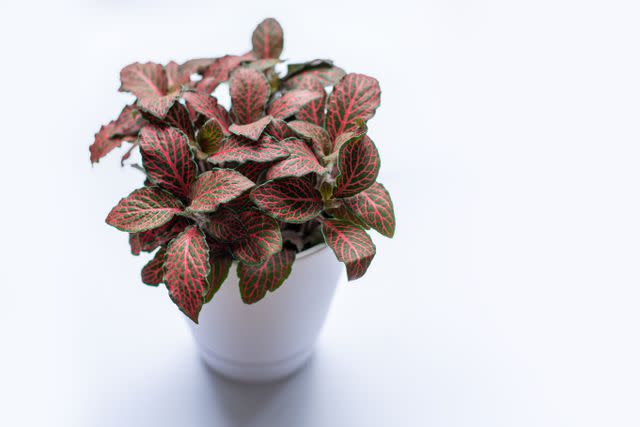
Getty Images
Botanical Name: Fittonia spp.
Sun Exposure: Medium to Bright Indirect Light
Soil Type: Well-draining, Rich
Soil pH: Slightly Acidic (5.5-6.5)
These low growing plants are a delight, with stunning variegation along the leaf veins, giving them their common name nerve plant. In addition to pink varieties, also look for red- or white-veined nerve plants. Nerve plants hail from the tropics and benefit from a humid environment. Mist plants regularly or try growing them in a terrarium. Nerve plants remain compact and pair well with taller houseplants like dracaena.
Earth Star Bromeliad

Getty Images
Botanical Name: Cryptanthus bivitattus
Sun Exposure: Medium to Bright Indoor Light
Soil Type: Moist, Well-draining
Soil pH: Acidic (5.0-6.0)
With compact, distinctly star-shaped rosettes and a compact habit, earth star bromeliads can be tucked just about anywhere. Their stiff, spiny foliage is striped in green and pink, with red and yellow varieties also available. Unlike other bromeliads that grow as epiphytes, earth stars live on the rain forest floor and produce a more robust root system than aerial species. They take up water from the soil, rather than from the cup of their foliage, thus need to be potted in a medium that holds moisture well.
Madagascar Dragon Tree
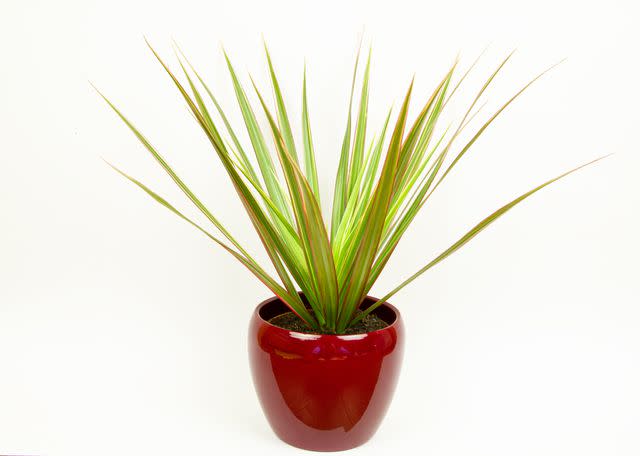
Getty Images
Botanical Name: Dracaena marginata 'Colorama'
Sun Exposure: Low to Bright Indoor Light
Soil Type: Moist, Well-draining, Rich
Soil pH: Slightly Acidic (6.0-6.5)
Add a pop of color and flair to any room with the spiky foliage of dracaena. Producing trunk-like stems over time, the aptly named dragon tree makes a bold architectural statement. The narrow leaf blades of 'Colorama' are distinctive for the vivid pink stripes along their edge. This adaptable houseplant tolerates a range of light conditions.
Echeveria
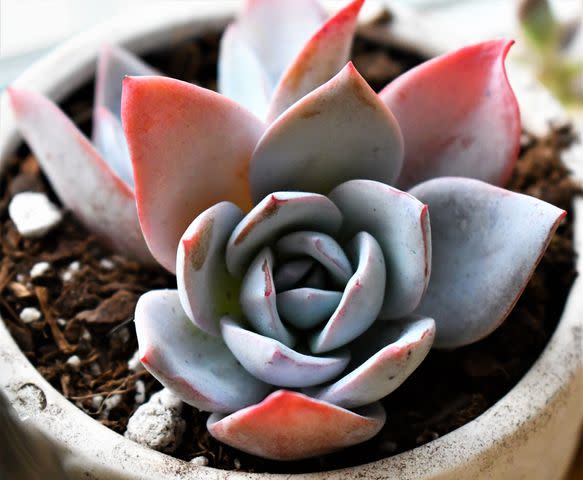
Getty Images / Devan Anderson
Botanical Name: Echeveria spp. and hybrids
Sun Exposure: Bright Direct or Indirect Light
Soil Type: Porous, Well-draining
Soil pH: Slightly Acidic (5.5-6.5)
Succulents are quintessential low-maintenance houseplants that provide an endless array of colors and forms. In this regard, echeverias do not disappoint. Growing as a compact rosette, the plump leaves of echeverias come in a range of colors, many featuring pink highlights against blue-green foliage for a dynamic color combination. Allow soil to dry between watering, then irrigate plants from the base to prevent water from sitting on the foliage.
Variegated String of Hearts
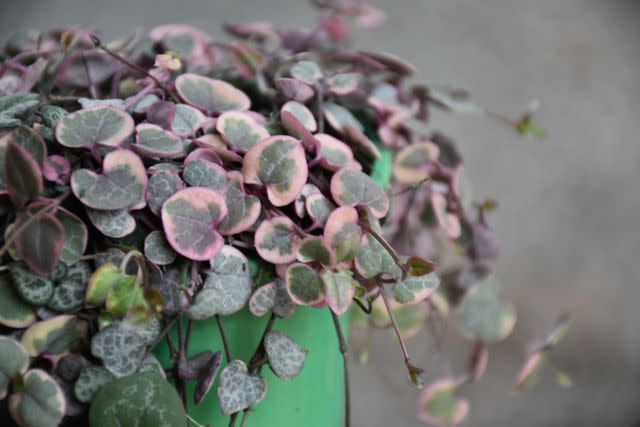
Getty Images / Suphanni Chongmithom
Botanical Name: Ceropegia woodii 'Variegata'
Sun Exposure: Bright Direct or Indirect Light
Soil Type: Porous, Well-draining
Soil pH: Acidic to Neutral (5.0-7.0)
The delightful heart-shaped leaves of variegated string of hearts combine a unique mix of mottled grey-green, white, and pink hues. Purple-red stems add additional color to this gracefully trailing plant that will cascade in long chains form hanging baskets. This succulent is easy to grow indoors, just provide good drainage and plenty of light.
Rubber Plant
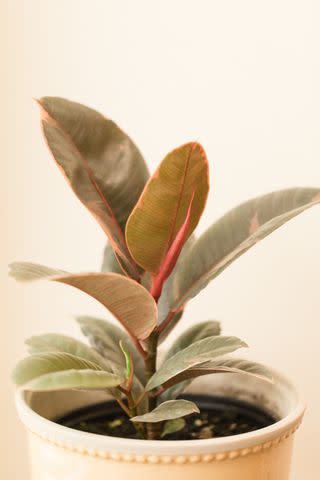
Getty Images / Crystal Bolin Photography
Botanical Name: Ficus elastica 'Ruby'
Sun Exposure: Medium to Bright Indirect Light
Soil Type: Well-draining, Rich
Soil pH: Slightly Acidic to Neutral (5.5-7.0)
One of the most popular houseplants for its large glossy leaves and radiant color, 'Ruby' rubber plant is truly one of a kind. Each waxy leaf can reach 10-15 inches, providing plenty of drama to indoor gardens. Unlike many of the plants on this list, rubber plant is not too picky about humidity, making it easy to grow under typical home conditions without the need for humidifiers or regular misting.
Triostar Stromanthe
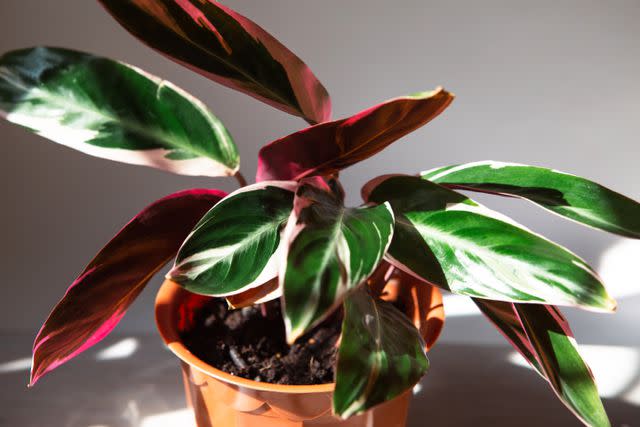
Getty Images
Botanical Name: Stromanthe sanguinea 'Triostar' (or 'Tricolor')
Sun Exposure: Bright Indirect Light
Soil Type: Well-draining, Rich
Soil pH: Slightly Acidic (5.5-6.2)
The stunning foliage of this tropical beauty brings extravagant color to the home. Thick elongated leaves are irregularly variegated on the upper surface with green, pink, and cream markings, while the undersides are either solid pink or maroon with pink variegation. This can be a challenging houseplant to grow thanks to its love of humidity. Try growing it in a bathroom with a regularly used shower or placing it near a humidifier.
Anthurium
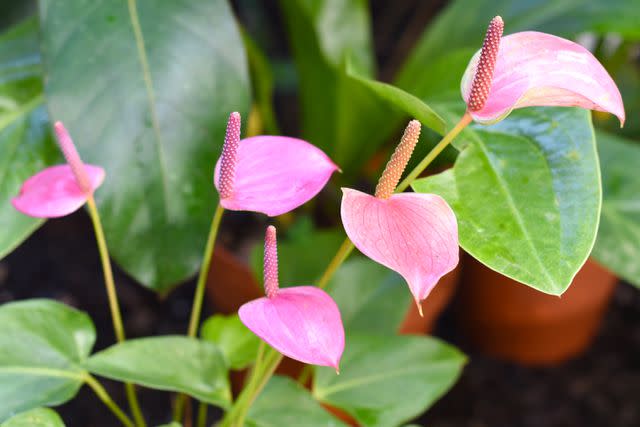
Getty Images / Tatiana Terekhina
Botanical Name: Anthurium andraeanum
Sun Exposure: Bright, Indirect Light
Soil Type: Well-draining
Soil pH: Slightly Acidic (5.5-6.5)
Complement all that pink foliage with the captivating blooms of anthurium. The “petal” of this elegant tropical is actually a modified leaf called a spathe which surrounds the upright spadix that contains the true flowers. Each inflorescence can last for up to three months, and healthy plants can bloom twice per year in spring and summer, providing long lasting color.
For more Southern Living news, make sure to sign up for our newsletter!
Read the original article on Southern Living.

